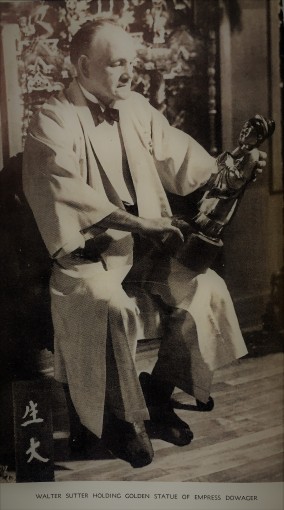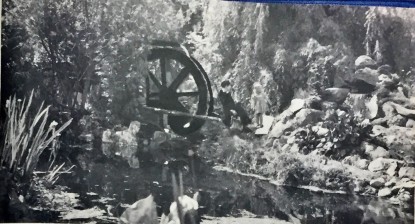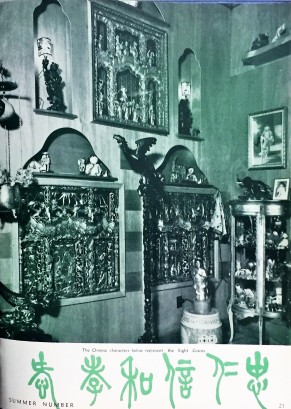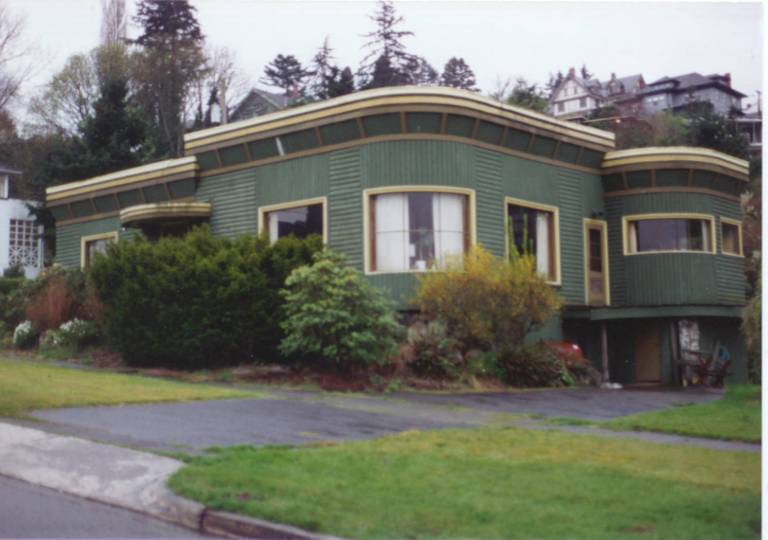Decades before the Chinese Reconciliation project was imagined on the Old Town waterfront, Tacoma’s first neighborhood was the site of an elaborate, idiosyncratic landmark called the House of Chinese Mystery. The building was a puzzle as were the ancient and lavish contents and the outright weird garden. It was all the work and passion of a man named Walter Sutter, and he was a Tacoma born puzzle too.
In the New Deal era WPA Guide to Washington State published in 1940 there is this unusual listing under Points of Interest in Tacoma:
THE CHINESE MUSEUM, N. 26th and Carr St, housed in a house of Walter Sutter, contains and extensive collection of Oriental art brought from Peking in 1937 and said to be from the Dragon Throne room. Seventeen carved teakwood panels overlain with beaten gold, two of silver worked with kingfishers feathers, ivory carvings, pottery, and and exhibition of 2000 Chinese dolls are on exhibit. The fireplace is inset with fluorescent rocks that glow softly by means of concealed neon lighting.
house of Walter Sutter, contains and extensive collection of Oriental art brought from Peking in 1937 and said to be from the Dragon Throne room. Seventeen carved teakwood panels overlain with beaten gold, two of silver worked with kingfishers feathers, ivory carvings, pottery, and and exhibition of 2000 Chinese dolls are on exhibit. The fireplace is inset with fluorescent rocks that glow softly by means of concealed neon lighting.
Before even mentioning the house itself, it seemed like a set from an Indiana Jones movie and that’s where the personality of Walt Sutter comes in. In his own autobiographical version of his life Walt left his seaport home in Tacoma in 1901 at 13 on a merchant vessel sailing to China and Siam where he worked as a cutter in the teak forests. While his self told adventures and daring escapes from danger don’t alway line up with historical dates and events he did eventually leave the sea as a registered Marine engineer and take up work, ironically as a safety engineer for the State and eventually the City of Tacoma. Then the big mystery story starts.
 Walt continued to travel back and forth between China and in the late 1920’s he made the acquaintance of the enigmatic leader of the Republic of China, Chiang Kai-chek. According to Walt, the diplomatic warlord was worried about loss of his country’s great art treasures from the Forbidden City of Perking during the ongoing war with Japan. He made a bargain. If Walt could build a safe place for the Dragon Room treasures, they would be entrusted to him. Walt the storyteller did not have the restraint to leave out the melodramatic caveat that through secret channels known only to himself, the treasure house had to be completed in 44 days.
Walt continued to travel back and forth between China and in the late 1920’s he made the acquaintance of the enigmatic leader of the Republic of China, Chiang Kai-chek. According to Walt, the diplomatic warlord was worried about loss of his country’s great art treasures from the Forbidden City of Perking during the ongoing war with Japan. He made a bargain. If Walt could build a safe place for the Dragon Room treasures, they would be entrusted to him. Walt the storyteller did not have the restraint to leave out the melodramatic caveat that through secret channels known only to himself, the treasure house had to be completed in 44 days.
So in the summer of 1936 Sutter began building a house that was to contain treasures of immeasurable value. As it happens the location was already filled with works of Walt Sutter’s overactive imagination.
In 1934 he had acquired the lower pools of the territorial era Tacoma waterworks at 26th and Carr where he and his wife Mabel began landscaping an Asian garden with “sparkling waterfalls and tiny lakes filled with fish in a setting of beautiful flowers, shrubs and trees.” Then, to make it a “Friendship Rockery”, they began collecting and  soliciting bits of geology. One from every county in Washington and every state in the country was easy and by the time he started on the house there 2000 tons of rocks on the site including a meteorite from Arizona and a pebble from the Mayor of Zweibrucken village in Germany. Newspaper stories and newsreel coverage fed the hard rock campaign and as the rocks came in Walt made metal labels for each one describing it place of origin and backstory. The flood of rockery peaked at 150 stones arriving in a single day. The stories came with them and the metal labels got bigger-a rock from a church in Manila that was destroyed by a chance shot from Dewey’s fleet, a piece of the Great Wall of China, a rock from the darkness of Mammoth Caves and one from the quarries where stonecutters carved out King Solomon’s Temple.
soliciting bits of geology. One from every county in Washington and every state in the country was easy and by the time he started on the house there 2000 tons of rocks on the site including a meteorite from Arizona and a pebble from the Mayor of Zweibrucken village in Germany. Newspaper stories and newsreel coverage fed the hard rock campaign and as the rocks came in Walt made metal labels for each one describing it place of origin and backstory. The flood of rockery peaked at 150 stones arriving in a single day. The stories came with them and the metal labels got bigger-a rock from a church in Manila that was destroyed by a chance shot from Dewey’s fleet, a piece of the Great Wall of China, a rock from the darkness of Mammoth Caves and one from the quarries where stonecutters carved out King Solomon’s Temple.
But the rocks and their stories became secondary to building the treasure house once the 44 day clock started in the summer of 1938. Walt started by clearing a building site and laying out a foundation, His crew dug a basement and poured a concrete perimeter wall in less than a week. With the artwork in mind, the envelope of the was framed in heavy cedar timber with 10 inch walls enclosing a grand front room around a massive stone fireplace, a formal dining room and kitchen that were connected by a ramped hall that created a theatrical presentation of meals. At the rear of the building were three bedrooms for the Sutter family including a master bedroom that had a private stairway to a rooftop deck, fashioned after a steamship deck looking out over Commencement Bay. There was a legend that Walt built a system of ball bearings under the bed to simulate the motion of the sea.
The Art Deco house was finished in time. As workmen completed the building and installed the unique curved plate glass picture windows, crates began to arrive full of carved panels, architectural details and decorative artworks. Whole walls of carved mahogany were delivered, ancient chandeliers, silk shaded floor lamps and gilded incense burners were placed perfectly. A pair of embossed silver kingfisher panels measuring seven feet across fit perfectly above the waterview windows and in the living room Walt created a massive stone fireplace faced in backlit translucent stones, geodes and polished agates.
As workmen completed the building and installed the unique curved plate glass picture windows, crates began to arrive full of carved panels, architectural details and decorative artworks. Whole walls of carved mahogany were delivered, ancient chandeliers, silk shaded floor lamps and gilded incense burners were placed perfectly. A pair of embossed silver kingfisher panels measuring seven feet across fit perfectly above the waterview windows and in the living room Walt created a massive stone fireplace faced in backlit translucent stones, geodes and polished agates.
Tacoma, and Old Town in particular, has  been a magnet for curious buildings like the old Seaman Rest, Rebecca Carr’s Fortune Telling cottage and even the Spar but nothing before or after Sutter’s Chinese Museum has even come close to its peculiar extravagance.
been a magnet for curious buildings like the old Seaman Rest, Rebecca Carr’s Fortune Telling cottage and even the Spar but nothing before or after Sutter’s Chinese Museum has even come close to its peculiar extravagance.
On November 21 1938, the Sutter hosted a black tie diner at the house with Mrs. Phillip Garland as the guest of honor. She had attended Wellesley College with the wife of Generalissimo Chiang Kai-Chek. The banker Reno Odlin, future Mayor Harry P Cain and newspaper heir N.S. Perkins were there for the high society event and a week later they opened the house to the public.
On weekends Walt and Mabel became curators and tour guides, narrating the collection of art for the thousand of people who came to the house. They attributed gold carvings to artisans of the Shin Huang Ti dynasty 200 B.C. and delicate “mud men” fired in clay to potters from 1200 years B.C. Some pieces were unremarkable trade items but undeniably there were rare treasures.
The fascination with Sutter’s Chinese museum continued through the late 1930 as Tacomans followed the news of the growing warfare in China. During the Second World War, Tacoma shipping increased along with secrecy about distances and destinations. With American troops fighting in the Pacific, the war in China became unimportant and Sutter’s museum followed. In April 1947, Walt and Mabel moved to Los Angeles for health reasons and in August news came that he had passed away. Movers had already arrived at the treasure house and the Museum contents were already in California. The vacant house was sold the next year for almost $50,000. Mable stayed in touch with her Tacoma friends and visited occasionally but she never talked about the thousands of objects and artworks. There whereabouts, like their origin became another part of Sutter’s Chinese Puzzle. It had existed in Tacoma for only ten years.

In the late 1980’s a developer got control of the treasure house and without even knowing the story, had the entire house and garden, including the remaining constellation of world-wide rocks, bulldozed to make room for a tightly packed development of mini-mansions.

As it turns out, Walter is buried here at the Tacoma Cemetery, as recorded on Find-a-Grave at https://www.findagrave.com/memorial/86179739
LikeLike
thank you so much. I appreciate your knowledge and the fact you share your stories with us. Lynn
LikeLike
Wonderful to see this great story. It was an amazing home and a shame to see such a unique structure be demolished. I was in the home for an unusual estate sale prior to the developer’s planned demolition as it included most building items. I salvaged the steam and victorian radiators, and some of the curved window glass. While we were there removing these items, my father enjoyed watching and feeding a large trout that would surface in the creek fed backyard pond. We stopped by up until the demolition to visit and feed the trout, which acted more like a pet that had been there for a long time. I have stored the radiators and curved window glass for many years. If you know of any organization interested in them that would arrange transport, please let me know at lynnett_a@hotmail.com
LikeLike